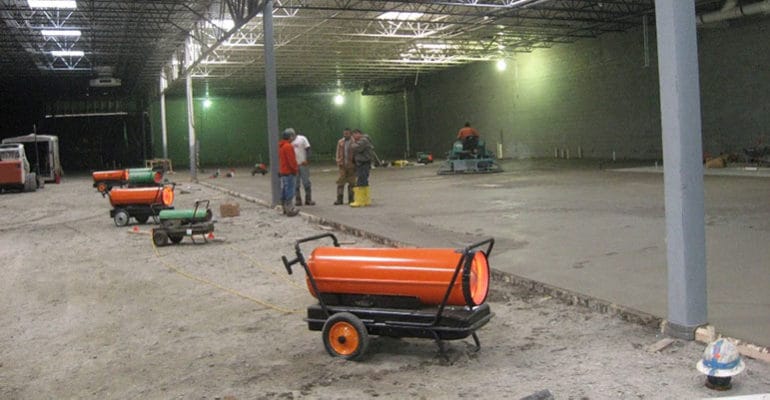Myths, Moisture & Carbon Monoxide Due to Recirculating Hot Air

There’s a question that seems to come up every winter. And every year, since BABFAR was founded in 1969, our answer has been the same.
Customers ask about using heaters inside an enclosure. Do You Prefer the Fuel Efficiency of a Direct-Fired Heater or the Safety of an Indirect-Fired Heater? What if You Could Have Both? Come learn more about the different types of temporary heater models.
Customers wonder if fuel efficiency can be improved by re-heating the air inside an enclosure. Sometimes manufacturers also propose this. It makes sense, right? A heater would burn less fuel to reheat air that’s already inside a building than it would to heat outside air that’s blown into a building, right? Wrong!
What’s worse, re-circulating air increases the amount of moisture in the building and raises carbon monoxide (CO) levels. So, for almost 50 years, BABFAR has never recommended using temporary heaters inside an enclosure. Instead, our approach has always been to circulate fresh, hot air through a building.
Positive Pressurization Distributes Heat and Fresh Air
Positive pressurization acts like an air curtain that you might find at your local grocery store that prevents cold air from entering the store. Strategically placed openings in a building help distribute heat and force air that has cooled to exit. Positive pressurization circulates heat and ensures a fresh air change inside a structure.
Temporary heaters are often placed indoors if they can’t be used with ductwork. As these units recirculate air inside an enclosure, they create negative pressurization. This means cold air is pulled into the building from doors, stairwells, tarp holes, and other openings. While these units might heat their immediate surroundings, they actually create cold drafts in the rest of the building.
Temporary heaters capable of blowing fresh outside air into a building can provide the benefits of positive pressurization. This requires that heaters have a high discharge temperature and cubic feet per minute (CFM) rating to force hot air through ductwork and the entire enclosure.
Fuel Efficiency Fallacy
This brings us to the topic of fuel efficiency. For similar-rated British Thermal Unit (BTU) heaters, there are significant differences in heat output, air circulation, and fuel consumption.
The table below illustrates how Heater B outperforms both Heater R and Heater O using these criteria. In addition, since Heater R and O are re-circulating heaters, they are like space heaters. So, multiple units will be required to heat the entire building. Of course, this increases fuel consumption.
| Unit | BTU | LPG Gal/Hr | CFM |
|---|---|---|---|
| Heater R (re-circulating unit) | 1.1m | 12.1 | 3,800 |
| Heater O (re-circulating unit) | 1.0m | 10.9 | 4,200 |
| Heater B (circulating unit) | 1.35m | 8.2 | 6,000 |
Don’t Skimp on Safety
Even if you don’t know what it is or its effects, when you hear the words “carbon monoxide” you intuitively think of danger. And you’re right. To ensure employee safety, CO levels are limited on construction projects. In fact, the City of Boston requires contractors to provide a fresh air source when heaters are used. Occupational Safety and Health Administration (OSHA) guidelines limit CO to 50 parts per million (ppm). The State of Massachusetts is even stricter at 35ppm.
Temporary heaters typically emit 2 – 6 ppm of CO. If your heater is drawing fresh outside air, the CO levels in the building will be well below MA and OSHA levels. But if you recycle and re-burn air, CO levels will increase over time. Given that heaters often run 24 hours a day, this should be concerning. Manufacturers of re-circulating units even state these units work “well in loose enclosures such as under concrete deck pours, masonry enclosures, and spot heat situations.” If these heaters are used indoors, there must be plenty of ventilation to keep CO levels at safe levels.
Minimize Moisture
Moisture is naturally created during the combustion process. A single 100,000 BTU/Hr heater generates about one gallon of water! Recirculating air inside a building compounds this phenomenon.
Units that heat outside air use only about 15% of the air for combustion, which is then blended with 85% ambient air before being distributed to the building. This approach is a more efficient way to keep a building warm and dry.
There is nothing stopping BABFAR from making temporary heaters for use indoors, except our conscience. Even if re-circulating hot air did improve fuel efficiency and did not produce excess moisture, we could not offer a product that introduces health risks to customers.




